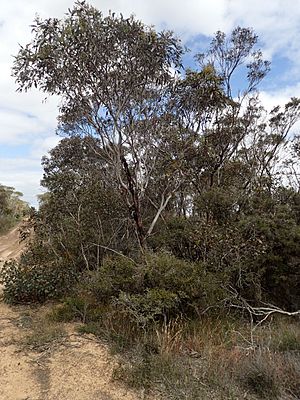Eucalyptus hebetifolia facts for kids
Quick facts for kids Eucalyptus hebetifolia |
|
|---|---|
 |
|
| Eucalyptus hebetifolia near the Stirling Range National Park | |
| Scientific classification | |
| Genus: |
Eucalyptus
|
| Species: |
hebetifolia
|
Eucalyptus hebetifolia is a unique type of eucalyptus tree that grows as a mallee. This means it's a shrubby tree with many stems coming from the ground. It is found only in southern Western Australia, making it a special plant from that area.
This eucalyptus has smooth, grey and brownish bark. Near the bottom of its trunk, you might see loose strips of bark. Its adult leaves are shaped like a spear. When it blooms, it has creamy white flowers that grow in groups. After the flowers, it produces fruit that looks like a cone or a small barrel.
Contents
What Does Eucalyptus hebetifolia Look Like?
Eucalyptus hebetifolia is a mallee that usually grows to be about 3 to 8 meters (10 to 26 feet) tall. The lower part of its trunk has rough, loose bark. Higher up, the bark is smooth and has grey and brownish colors.
Leaves and Flowers
- Young Leaves: When the plant is young, or if new shoots grow from the base, its leaves are broadly spear-shaped. They are about 50 to 95 millimeters (2 to 3.7 inches) long and 17 to 53 millimeters (0.7 to 2.1 inches) wide.
- Adult Leaves: The mature leaves are also spear-shaped. They are a dull bluish-green color on both sides. These leaves are about 70 to 90 millimeters (2.8 to 3.5 inches) long and 10 to 17 millimeters (0.4 to 0.7 inches) wide. They grow on a stalk called a petiole, which is about 9 to 20 millimeters (0.4 to 0.8 inches) long.
- Flower Buds: The flower buds grow in groups of up to thirteen. They are found where the leaves meet the stem. Each group of buds is on a stalk about 10 to 15 millimeters (0.4 to 0.6 inches) long. The individual buds are spindle-shaped, about 10 to 16 millimeters (0.4 to 0.6 inches) long.
- Flowering Time: This mallee usually blooms between December and March. Its flowers are a lovely creamy white or very pale yellow color.
- Fruit: After flowering, the plant produces woody fruit. These fruits are shaped like a barrel or a cone. They are about 6 to 8 millimeters (0.2 to 0.3 inches) long and 5 to 6 millimeters (0.2 inches) wide.
How Was This Plant Named?
The scientific name Eucalyptus hebetifolia was first officially described in 1991. Two scientists, Ian Brooker and Stephen Hopper, gave it this name. They found a sample of the plant near a place called Tincurrin.
The name hebetifolia comes from two Latin words:
- hebes means 'dull'
- folium means 'leaf'
So, hebetifolia means 'dull-leaved'. This name was chosen because its leaves are dull, unlike the shiny leaves of a similar plant called E. phaenophylla.
Where Does Eucalyptus hebetifolia Grow?
This special mallee grows in Western Australia. You can find it on higher ground in rolling hills. It prefers sandy-loamy soils that are found over a type of rock called laterite. It mainly grows in the central part of the Wheatbelt region.
Is This Plant Endangered?
The Western Australian Government's Department of Parks and Wildlife has looked at Eucalyptus hebetifolia. They have classified it as "not threatened." This means that, for now, there are enough of these plants, and they are not considered to be in danger of disappearing.



